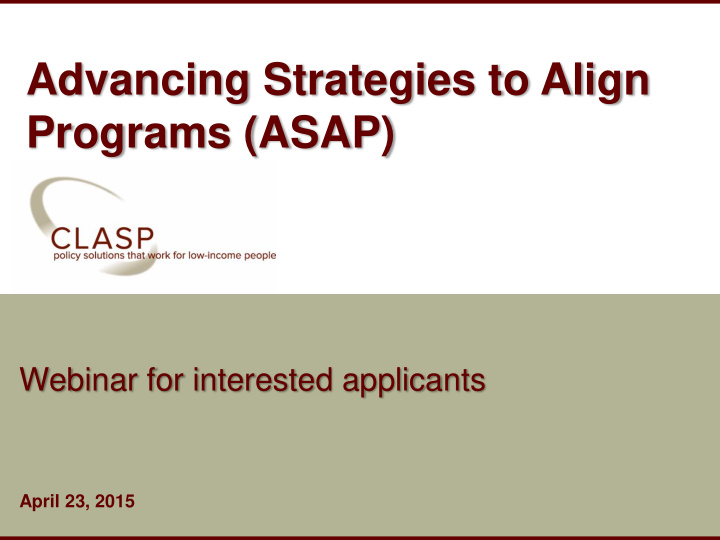



Advancing Strategies to Align Programs (ASAP) Webinar for interested applicants April 23, 2015 www.clasp.org
Cross-Program Eligibility 98% Of Non-Seniors Eligible For SNAP Will Be Eligible For Medicaid 63% Of Non-Seniors Eligible For Medicaid Will Be Eligible For SNAP Source: rce: CBPP analysis of the Current Population Survey, 2010. 2 www.clasp.org
Source: Opportunities Under the Affordable Care Act for Human Service Programs To Modernize Eligibility Systems and Expedite Eligibility Determination (Urban Institute, Stan Dorn) www.clasp.org 3
Note: Program participation among citizen children with family income below the poverty level and no reported health insurance. The data should be viewed with caution. 2011 Data. Source: CBPP analysis of a Survey of Income and Program Participation. www.clasp.org
• Less churn in benefit receipt • Less time spent in applying and maintaining eligibility for programs • Potential for administrative cost-savings to states/counties – less red tape www.clasp.org 5
• Increased Medicaid eligibility • Increased attention to outreach/enrollment • Many new participants • 90/10 money for IT • Waiver of cost allocation (A-87) www.clasp.org 6
Advancing Strategies to Align Programs (ASAP) • Grants to advocates in up to 5 states • Technical assistance • Learning community www.clasp.org 7
1. Increase participation in a package of core safety net programs 2. Share lessons learned with other state advocates and leverage information to advance positive policy at the federal level www.clasp.org 8
Image thanks to Shelley Waters Boots www.clasp.org 9
• Using existing data in one program (SNAP) to enroll people in another program (Medicaid) • Expanding application options • Align redetermination across programs • Improving local office processes • Reduce burdensome verification requirements • Collect and use data on cross-program participation, timeliness, etc. www.clasp.org 10
• Pushing state to make program integration a priority and holding states accountable • Bringing cross-program policy expertise to the effort • Requesting and monitoring data to track improvements • Using communications to advance program integration www.clasp.org 11
• One organization serves as the lead and employs project director • Policy knowledge - human services and health • History of strong relationship building • Organizational capacity • Commitment to participate in learning community www.clasp.org 12
CLASP Team: Elizabeth Lower-Basch, Director of Income and Work Supports Suzanne Wikle, ASAP Project Director Nune Phillips, ASAP Project Coordinator CBPP Team: Stacy Dean, VP for Food Assistance Policy Judy Solomon, VP for Health Policy Jen Wagner, Senior Policy Analyst www.clasp.org 13
Key Dates: May 1 – Letter of Intent due May 29 – Full Proposal due June and July – Site Visits to Finalists End of July – Awards Announced Submit letters of intent and full proposals to: Suzanne Wikle, swikle@clasp.org and Nune Phillips, nphillips@clasp.org www.clasp.org 14
Please submit questions through the question feature on the webinar. If you have questions after today, please contact Suzanne Wikle at swikle@clasp.org www.clasp.org 15
Recommend
More recommend